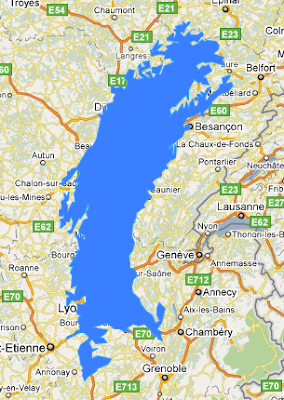Hydroelectricity is -at least at the plant itself- a clean and renewable form of electricity generation; it is driven by the water cycle, which in itself is a manifestation of solar energy.
The main mechanism by which a hydroelectric power plant generates energy is by converting the water's potential gravitational energy (dictated by the surface-level difference above and below the dam) into kinetic energy of the turbines, and from there into electrical energy. The electrically generated power can thus be calculated in a
- P is Power in watts,
- ρ is the density of water (~1000 kg/m3),
- h is height in meters,
- r is flow rate in cubic meters per second,
- g is acceleration due to gravity of 9.8 m/s2,
- k is a coefficient of efficiency ranging from 0 to 1.
It is clear that ρ and g are constants, and that -for any sufficiently large-scale system- k will not be too changeable either. So, basically, if we wish to generate a lot of power, we need a high drop and a high flow rate. This leaves of with the task of choosing a large river on which we can generate a high drop by building a large dam. Obviously, the further downstream we can build the dam, the larger our catchment basin becomes, and the higher the flow rate.
Now, Europe does not have very-high flow-rate rivers compared to, e.g., South America, Asia, or Africa, but Europe does have three relatively-high flow-rate rivers where a natural canyon downstream can be used to create a high drop. These are: The Rhône, the Rhine, and the Danube.
In this post, I will describe a totally ridiculous-scale hydroelectricity project on the Rhône. This project could never ever be executed, due to social, ecological, and economical constraints, but that does not stop me from assessing how much electrical energy we could generate in the extreme case (yes, this blog has "extreme" in its title!).
Some 60 km South of the French city of Lyon, the Rhône passes
Saint Vallier, where an Eastern outcropping of the Massiv Central and a Western outcropping of the Alps creates a canyon. Here, a dam can be erected.
As we determined earlier, we now have a high-flow-rate spot, but we need a high drop, too. So how high can we go here? In order to find out, I downloaded the freely-available
GTOPO30 digital elevation model, which contains elevation data for the entire world at 120x120 points per square degree. Using Octave, I generated contour lines at increasing elevations until the reservoir lake spilled over the lowest point of the water shed between the Rhône catchment basin and an other catchment basin.
As it turns out, the lowest point on the basin's water shed is that between the Rhône basin and the Loire catchment basin, in the
Canal du Centre at 298 meters above sea level, around
here. This means that if we leave a precautionary 8-meter head room, we can raise the lake surface to 290 meters above sea level. This creates "
Lac du Rhône", which has a considerable size:
In fact, this reservoir utterly dwarfs Lake Geneva, which creates the small trouble of forcing millions of people to move, etc. However, from a purely technical point of view, it is possible. Now, let's find out how much power we get out of this setup.
In Saint-Vallier, the Rhone flows at 131 meters above sea level. This means that is we raise the water in the reservoir to 290 meters above sea level, we have a drop of h = 159 meters. The next unknown is the flow rate.
This site on Rhone flow rates lists an annual average of 1100 m3/s at Ternay, which is just a bit upstream from our dam, and -just like our dam- upstream from the confluence with the rather large Isere.
The final unknown is the efficiency of the generators. I have not found solid data, but it seems that 0.5 is a safe bet.
Using these figures gets us:
P = ρhrgk = 1000 * 161 * 1100 * 9.81 * 0.5 = 868.6 MW
This would be an average over the year. Using the maximum flow rate of ~2700 m3/s would give us a peak power output of 2.132 GW. Over the course of a year (on average, 8766 hours), the average power output would get us 7.61 TWh, or 2.74e+16 Joules.
Putting that into perspective, that would be 0.27% of the EU27 electricity usage... pretty sobering, isn't it?
Now, the question is, can we do better than this?
Hey, I am an engineer; of course we can do better than this! See you next time...


